MITSUBISHI OUTLANDER PHEV 2016 Owner's Manual (in English)
Manufacturer: MITSUBISHI, Model Year: 2016, Model line: OUTLANDER PHEV, Model: MITSUBISHI OUTLANDER PHEV 2016Pages: 490, PDF Size: 22.02 MB
Page 131 of 490
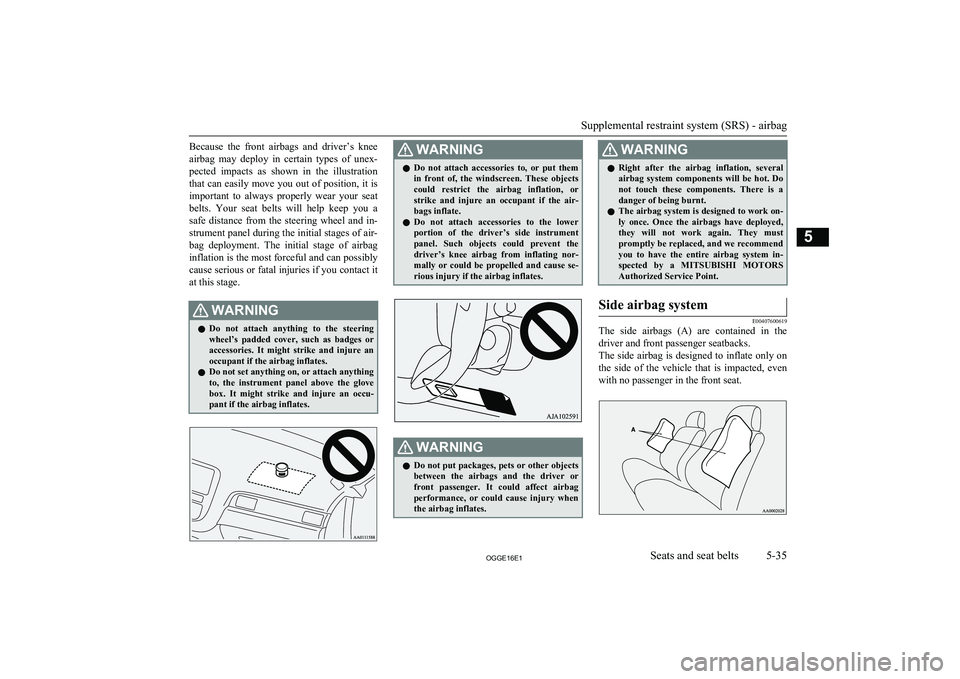
Because the front airbags and driver’s knee
airbag may deploy in certain types of unex- pected impacts as shown in the illustration that can easily move you out of position, it is important to always properly wear your seat belts. Your seat belts will help keep you a
safe distance from the steering wheel and in- strument panel during the initial stages of air-
bag deployment. The initial stage of airbag inflation is the most forceful and can possibly
cause serious or fatal injuries if you contact it
at this stage.WARNINGl Do not attach anything to the steering
wheel’s padded cover, such as badges or accessories. It might strike and injure an
occupant if the airbag inflates.
l Do not set anything on, or attach anything
to, the instrument panel above the glove box. It might strike and injure an occu- pant if the airbag inflates.WARNINGl Do not attach accessories to, or put them
in front of, the windscreen. These objects
could restrict the airbag inflation, or strike and injure an occupant if the air-
bags inflate.
l Do not attach accessories to the lower
portion of the driver’s side instrumentpanel. Such objects could prevent the
driver’s knee airbag from inflating nor-
mally or could be propelled and cause se- rious injury if the airbag inflates.WARNINGl Do not put packages, pets or other objects
between the airbags and the driver orfront passenger. It could affect airbagperformance, or could cause injury when the airbag inflates.WARNINGl Right after the airbag inflation, several
airbag system components will be hot. Do
not touch these components. There is a
danger of being burnt.
l The airbag system is designed to work on-
ly once. Once the airbags have deployed,
they will not work again. They must
promptly be replaced, and we recommend you to have the entire airbag system in-spected by a MITSUBISHI MOTORS
Authorized Service Point.Side airbag system
E00407600619
The side airbags (A) are contained in the
driver and front passenger seatbacks.
The side airbag is designed to inflate only on the side of the vehicle that is impacted, evenwith no passenger in the front seat.
Supplemental restraint system (SRS) - airbag
5-35OGGE16E1Seats and seat belts5
Page 132 of 490
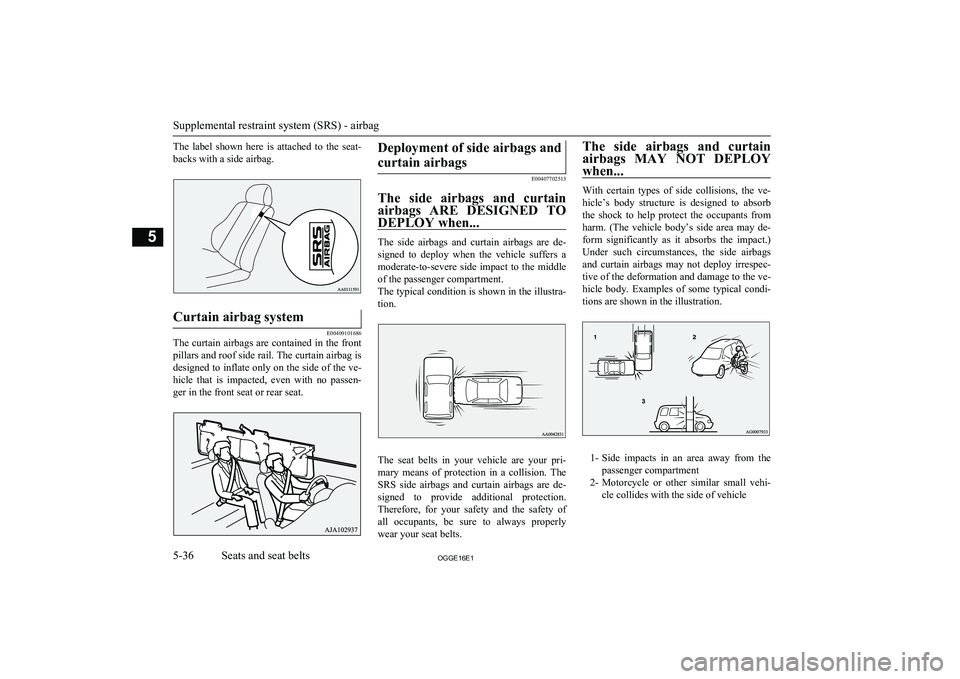
The label shown here is attached to the seat-backs with a side airbag.Curtain airbag system
E00409101686
The curtain airbags are contained in the front pillars and roof side rail. The curtain airbag is
designed to inflate only on the side of the ve- hicle that is impacted, even with no passen- ger in the front seat or rear seat.
Deployment of side airbags and
curtain airbags
E00407702513
The side airbags and curtain airbags ARE DESIGNED TO
DEPLOY when...
The side airbags and curtain airbags are de- signed to deploy when the vehicle suffers a
moderate-to-severe side impact to the middle of the passenger compartment.
The typical condition is shown in the illustra- tion.
The seat belts in your vehicle are your pri-mary means of protection in a collision. The SRS side airbags and curtain airbags are de-
signed to provide additional protection. Therefore, for your safety and the safety of all occupants, be sure to always properly
wear your seat belts.
The side airbags and curtain
airbags MAY NOT DEPLOY
when...
With certain types of side collisions, the ve- hicle’s body structure is designed to absorb
the shock to help protect the occupants fromharm. (The vehicle body’s side area may de-form significantly as it absorbs the impact.) Under such circumstances, the side airbags
and curtain airbags may not deploy irrespec- tive of the deformation and damage to the ve-
hicle body. Examples of some typical condi- tions are shown in the illustration.
1- Side impacts in an area away from the
passenger compartment
2- Motorcycle or other similar small vehi-
cle collides with the side of vehicle
Supplemental restraint system (SRS) - airbag
5-36OGGE16E1Seats and seat belts5
Page 133 of 490
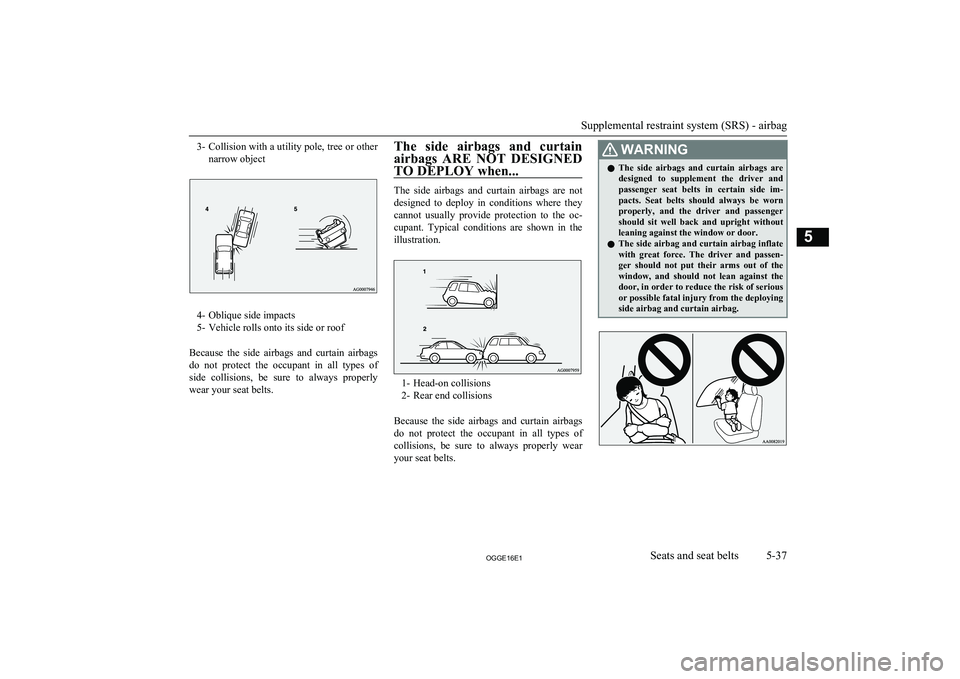
3-Collision with a utility pole, tree or other
narrow object
4- Oblique side impacts
5- Vehicle rolls onto its side or roof
Because the side airbags and curtain airbags do not protect the occupant in all types of side collisions, be sure to always properlywear your seat belts.
The side airbags and curtain
airbags ARE NOT DESIGNED TO DEPLOY when...
The side airbags and curtain airbags are notdesigned to deploy in conditions where they
cannot usually provide protection to the oc- cupant. Typical conditions are shown in the
illustration.
1- Head-on collisions
2- Rear end collisions
Because the side airbags and curtain airbags do not protect the occupant in all types of collisions, be sure to always properly wearyour seat belts.
WARNINGl The side airbags and curtain airbags are
designed to supplement the driver and passenger seat belts in certain side im-
pacts. Seat belts should always be worn properly, and the driver and passenger
should sit well back and upright without
leaning against the window or door.
l The side airbag and curtain airbag inflate
with great force. The driver and passen- ger should not put their arms out of the window, and should not lean against the
door, in order to reduce the risk of serious
or possible fatal injury from the deploying
side airbag and curtain airbag.
Supplemental restraint system (SRS) - airbag
5-37OGGE16E1Seats and seat belts5
Page 134 of 490
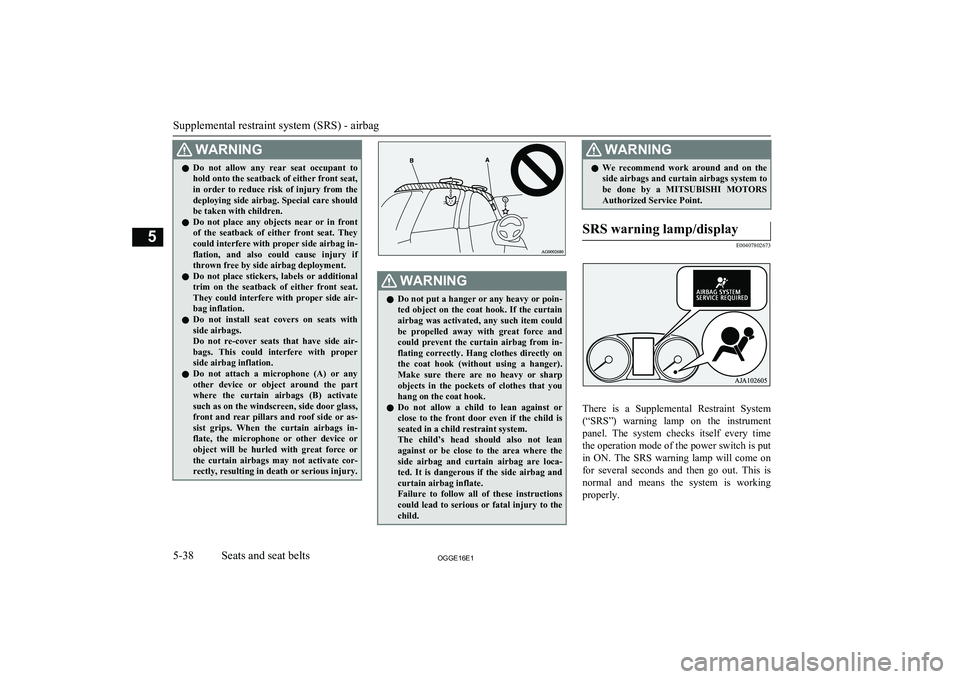
WARNINGlDo not allow any rear seat occupant to
hold onto the seatback of either front seat,
in order to reduce risk of injury from the
deploying side airbag. Special care should
be taken with children.
l Do not place any objects near or in front
of the seatback of either front seat. They could interfere with proper side airbag in-
flation, and also could cause injury if thrown free by side airbag deployment.
l Do not place stickers, labels or additional
trim on the seatback of either front seat. They could interfere with proper side air-bag inflation.
l Do not install seat covers on seats with
side airbags.
Do not re-cover seats that have side air-
bags. This could interfere with proper side airbag inflation.
l Do not attach a microphone (A) or any
other device or object around the part
where the curtain airbags (B) activate
such as on the windscreen, side door glass, front and rear pillars and roof side or as- sist grips. When the curtain airbags in-
flate, the microphone or other device or object will be hurled with great force orthe curtain airbags may not activate cor-
rectly, resulting in death or serious injury.WARNINGl Do not put a hanger or any heavy or poin-
ted object on the coat hook. If the curtain
airbag was activated, any such item could
be propelled away with great force and could prevent the curtain airbag from in-
flating correctly. Hang clothes directly on the coat hook (without using a hanger).
Make sure there are no heavy or sharp objects in the pockets of clothes that you
hang on the coat hook.
l Do not allow a child to lean against or
close to the front door even if the child is
seated in a child restraint system.
The child’s head should also not lean against or be close to the area where the
side airbag and curtain airbag are loca-
ted. It is dangerous if the side airbag and curtain airbag inflate.
Failure to follow all of these instructions
could lead to serious or fatal injury to the
child.WARNINGl We recommend work around and on the
side airbags and curtain airbags system to
be done by a MITSUBISHI MOTORS
Authorized Service Point.SRS warning lamp/display
E00407802673
There is a Supplemental Restraint System
(“SRS”) warning lamp on the instrument
panel. The system checks itself every time
the operation mode of the power switch is put in ON. The SRS warning lamp will come on
for several seconds and then go out. This is
normal and means the system is working
properly.
Supplemental restraint system (SRS) - airbag
5-38OGGE16E1Seats and seat belts5
Page 135 of 490
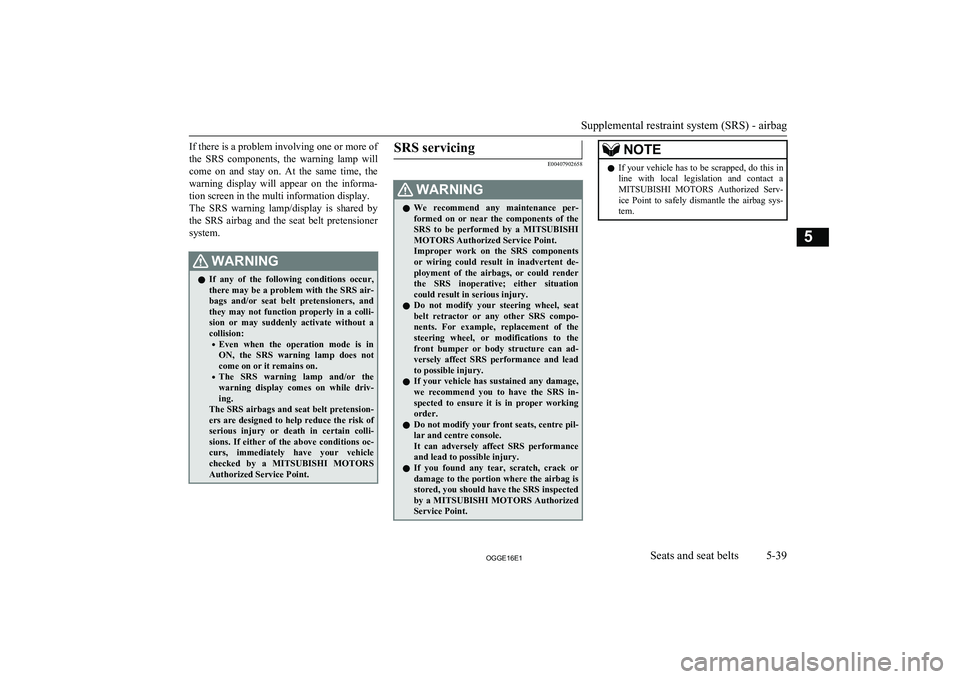
If there is a problem involving one or more of
the SRS components, the warning lamp will come on and stay on. At the same time, the
warning display will appear on the informa- tion screen in the multi information display.
The SRS warning lamp/display is shared by
the SRS airbag and the seat belt pretensioner system.WARNINGl If any of the following conditions occur,
there may be a problem with the SRS air- bags and/or seat belt pretensioners, and they may not function properly in a colli-
sion or may suddenly activate without a
collision:
• Even when the operation mode is in
ON, the SRS warning lamp does notcome on or it remains on.
• The SRS warning lamp and/or the
warning display comes on while driv- ing.
The SRS airbags and seat belt pretension- ers are designed to help reduce the risk of
serious injury or death in certain colli- sions. If either of the above conditions oc-
curs, immediately have your vehicle checked by a MITSUBISHI MOTORS
Authorized Service Point.SRS servicing
E00407902658
WARNINGl We recommend any maintenance per-
formed on or near the components of the
SRS to be performed by a MITSUBISHI
MOTORS Authorized Service Point.
Improper work on the SRS components or wiring could result in inadvertent de-
ployment of the airbags, or could render
the SRS inoperative; either situation could result in serious injury.
l Do not modify your steering wheel, seat
belt retractor or any other SRS compo-
nents. For example, replacement of the
steering wheel, or modifications to the
front bumper or body structure can ad- versely affect SRS performance and lead
to possible injury.
l If your vehicle has sustained any damage,
we recommend you to have the SRS in- spected to ensure it is in proper workingorder.
l Do not modify your front seats, centre pil-
lar and centre console.
It can adversely affect SRS performance and lead to possible injury.
l If you found any tear, scratch, crack or
damage to the portion where the airbag is
stored, you should have the SRS inspected
by a MITSUBISHI MOTORS Authorized
Service Point.NOTEl If your vehicle has to be scrapped, do this in
line with local legislation and contact a
MITSUBISHI MOTORS Authorized Serv-
ice Point to safely dismantle the airbag sys- tem.
Supplemental restraint system (SRS) - airbag
5-39OGGE16E1Seats and seat belts5
Page 136 of 490
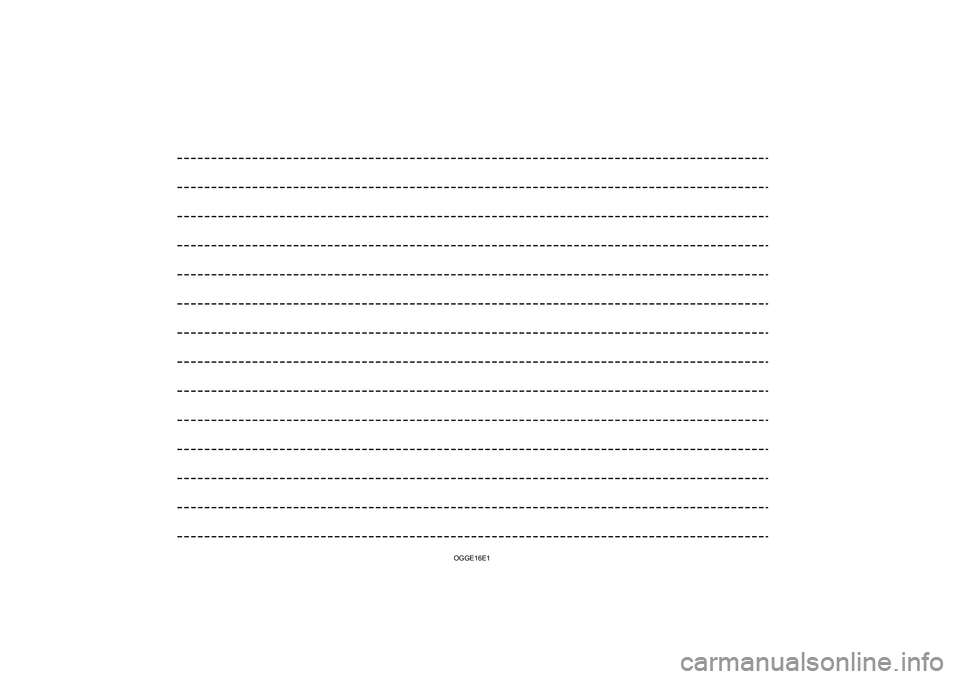
OGGE16E1
Page 137 of 490
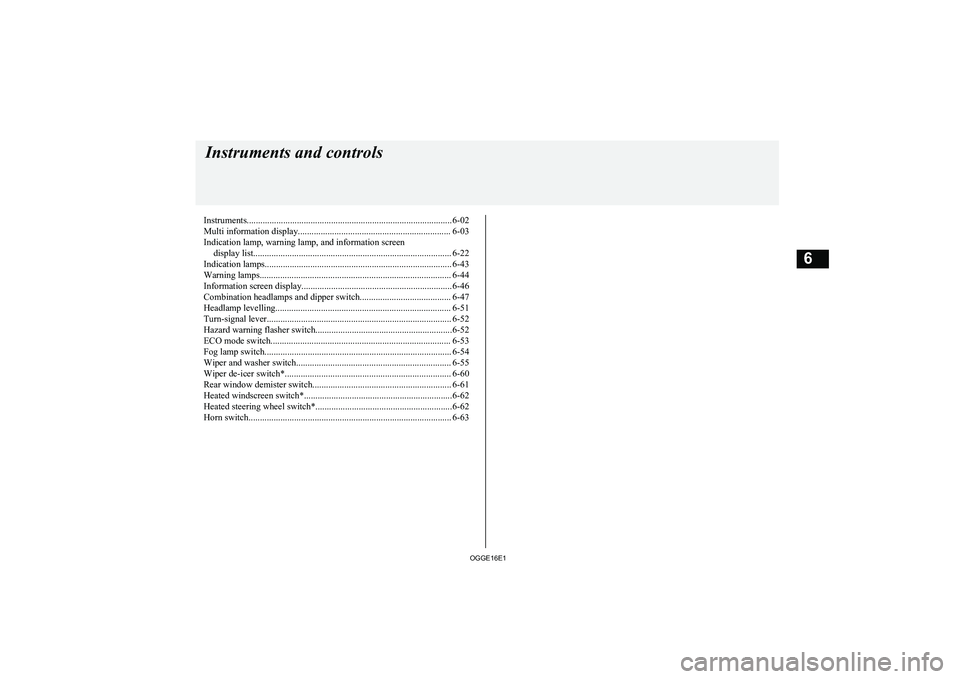
Instruments.......................................................................................... 6-02
Multi information display................................................................... 6-03
Indication lamp, warning lamp, and information screen display list....................................................................................... 6-22
Indication lamps.................................................................................. 6-43
Warning lamps.................................................................................... 6-44
Information screen display.................................................................. 6-46
Combination headlamps and dipper switch........................................ 6-47
Headlamp levelling............................................................................. 6-51
Turn-signal lever................................................................................. 6-52
Hazard warning flasher switch............................................................6-52 ECO mode switch............................................................................... 6-53
Fog lamp switch.................................................................................. 6-54
Wiper and washer switch.................................................................... 6-55
Wiper de-icer switch*......................................................................... 6-60
Rear window demister switch............................................................. 6-61
Heated windscreen switch*.................................................................6-62 Heated steering wheel switch*............................................................6-62Horn switch......................................................................................... 6-63Instruments and controls
OGGE16E16
Page 138 of 490
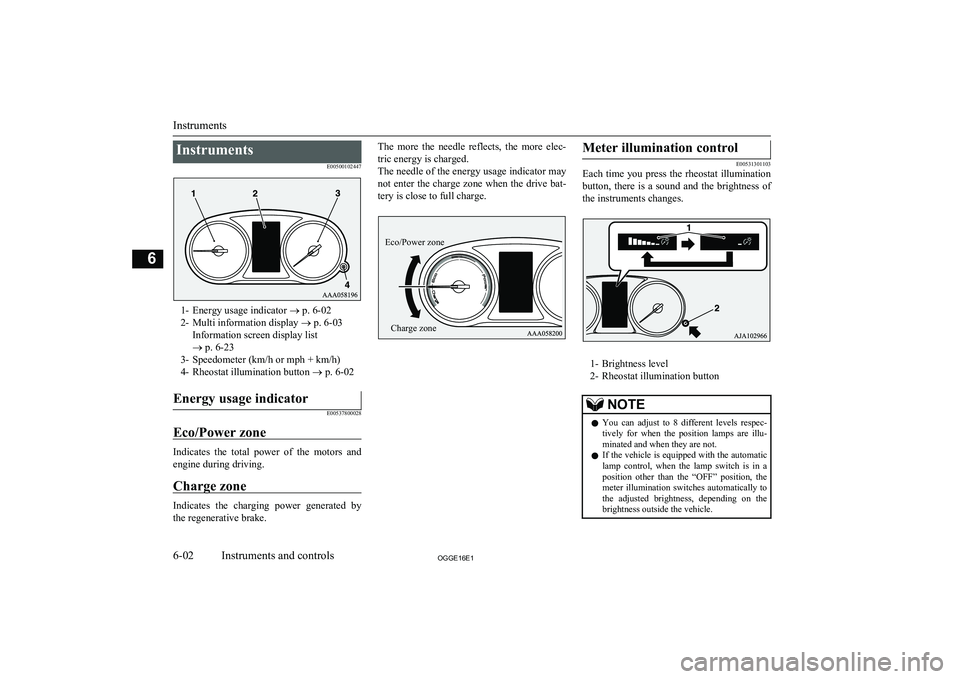
InstrumentsE00500102447
1- Energy usage indicator ® p. 6-02
2- Multi information display ® p. 6-03
Information screen display list
® p. 6-23
3- Speedometer (km/h or mph + km/h)
4- Rheostat illumination button ® p. 6-02
Energy usage indicator
E00537800028
Eco/Power zone
Indicates the total power of the motors and
engine during driving.
Charge zone
Indicates the charging power generated by the regenerative brake.
The more the needle reflects, the more elec-
tric energy is charged.
The needle of the energy usage indicator may not enter the charge zone when the drive bat-tery is close to full charge.Meter illumination control
E00531301103
Each time you press the rheostat illumination
button, there is a sound and the brightness of the instruments changes.
1- Brightness level
2- Rheostat illumination button
NOTEl You can adjust to 8 different levels respec-
tively for when the position lamps are illu- minated and when they are not.
l If the vehicle is equipped with the automatic
lamp control, when the lamp switch is in a position other than the “OFF” position, the
meter illumination switches automatically to
the adjusted brightness, depending on the brightness outside the vehicle.
Instruments
6-02OGGE16E1Instruments and controls6 Eco/Power zoneCharge zone
Page 139 of 490

NOTElThe brightness level of the instruments is
stored when the operation mode of the pow-
er switch is put in OFF.
l If you press and hold the button for about 2
seconds or more when the position lamps are
illuminated, the brightness level changes to
the maximum level. Pressing and holding the button for about 2 seconds or more again returns the brightness level to the previous
level.
On vehicles equipped with MITSUBISHI
Multi-Communication System (MMCS), the map screen colour of MITSUBISHI Multi-
Communication System (MMCS) may not be switched to nighttime setting when the
meter illumination brightness level is at the maximum.Multi information display
E00519902526
Always stop the vehicle in a safe place beforeoperating.
The following information is included on the
multi information display: warnings, odome-
ter, tripmeter, average fuel consumption, EV cruising range, total cruising range, EVHV
driving rate, energy flow, etc.
[When the operation mode of the power switch is OFF]
1- mark display screen ® p. 6-10
2- Information screen ® p. 6-06
Interrupt display screen ® p. 6-09
3- Drive battery level display screen
® p. 6-10
4- Odometer ® p. 6-11
5- “
” or “ ” “mark indicator” on page
6-09
6- Door ajar warning display screen
® p. 6-10
NOTEl The drive battery level display screen ap-
pears when any of the doors or the tailgate is
opened during charging.
[When the operation mode of the power
switch is ON]
Multi information display
6-03OGGE16E1Instruments and controls6
Page 140 of 490

1- NORMAL indicator display screenDisplayed when the ECO mode switchand 4WD lock switch are OFF.
2- ECO mode indicator display screen Displayed when the ECO mode switch isON and the 4WD lock switch is OFF.
3- ECO LOCK indicator display screen Displayed when the ECO mode switchand 4WD lock switch are ON.
4- 4WD LOCK indicator display screen Displayed when the ECO mode switch isOFF and the 4WD lock switch is ON.→ “ECO mode switch” on page 6-53
→ “4WD lock switch” on page 7-18
5- Battery charge mode display screen
® p. 7-22
6- Battery save mode display screen
® p. 7-217- mark display screen ® p. 6-10
8- Forward Collision Mitigation System
(FCM) OFF display screen* ® p. 7-55
“Ultrasonic misacceleration Mitigation-
System OFF display screen*” on page 7-63
9- Lane Departure Warning (LDW) display
screen* ® p. 7-69
10- Cruise control display screen*
® p. 7-34
11- Adaptive Cruise Control System (ACC)
display screen* ® p. 7-43
12- Speed limiter display screen*
® p. 7-38
13- Drive battery level display screen
® p. 6-10
14- Odometer ® p. 6-1115- “ ” or “ ” “mark indicator” on page
6-09
16- Information screen ® p. 6-08
17- Select position indicator ® p. 7-14
18- Fuel remaining display screen
® p. 6-10
19- Outside temperature display screen
® p. 6-11
Multi information display
6-04OGGE16E1Instruments and controls6